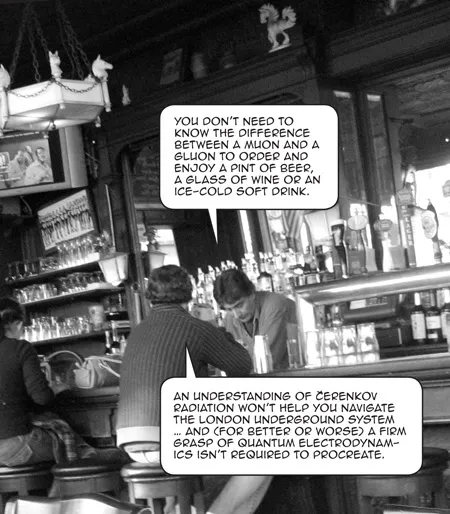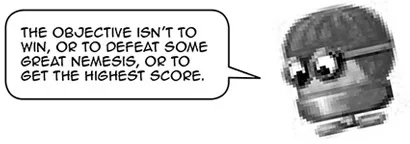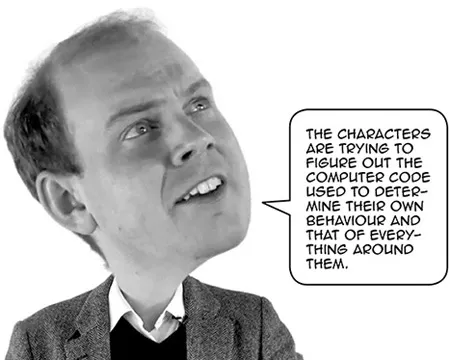
This is a test
- 192 pages
- English
- ePUB (mobile friendly)
- Available on iOS & Android
eBook - ePub
Book details
Book preview
Table of contents
Citations
About This Book
What really happens at the most fundamental levels of nature?Introducing Particle Physics explores the very frontiers of our knowledge, even showing how particle physicists are now using theory and experiment to probe our very concept of what is real. From the earliest history of the atomic theory through to supersymmetry, micro-black holes, dark matter, the Higgs boson, and the possibly mythical graviton, practising physicist and CERN contributor Tom Whyntie gives us a mind-expanding tour of cutting-edge science.Featuring brilliant illustrations from Oliver Pugh, Introducing Particle Physics is a unique tour through the most astonishing and challenging science being undertaken today.
Frequently asked questions
At the moment all of our mobile-responsive ePub books are available to download via the app. Most of our PDFs are also available to download and we're working on making the final remaining ones downloadable now. Learn more here.
Both plans give you full access to the library and all of Perlego’s features. The only differences are the price and subscription period: With the annual plan you’ll save around 30% compared to 12 months on the monthly plan.
We are an online textbook subscription service, where you can get access to an entire online library for less than the price of a single book per month. With over 1 million books across 1000+ topics, we’ve got you covered! Learn more here.
Look out for the read-aloud symbol on your next book to see if you can listen to it. The read-aloud tool reads text aloud for you, highlighting the text as it is being read. You can pause it, speed it up and slow it down. Learn more here.
Yes, you can access Introducing Particle Physics by Tom Whyntie,Oliver Pugh in PDF and/or ePUB format, as well as other popular books in Physical Sciences & Nuclear Physics. We have over one million books available in our catalogue for you to explore.
Information
Topic
Physical SciencesSubtopic
Nuclear PhysicsWhat are we made of?
It’s probably fair to say that we may live a reasonably enjoyable, profitable, and/or meaningful life without knowing the answer to the question: “What is a quark?”

YOU DON’T NEED TO KNOW THE DIFFERENCE BETWEEN A MUON AND A GLUON TO ORDER AND ENJOY A PINT OF BEER, A GLASS OF WINE OR AN ICE-COLD SOFT DRINK.
AN UNDERSTANDING OF CERENKOV RADIATION WON’T HELP YOU NAVIGATE THE LONDON UNDERGROUND SYSTEM … AND (FOR BETTER OR WORSE) A FIRM GRASP OF QUANTUM ELECTRODYNAM- ICS ISN’T REQUIRED TO PROCREATE.
However, if you should stop to think …
… you will have inadvertently embarked on one of the greatest intellectual, philosophical and scientific journeys it is possible to make.

WHAT IS THIS DELICIOUS AND REFRESHING BEVERAGE MADE OF?
WHAT IS THIS TABLE MADE OF?
WHAT ARE ALL THESE SWEATY, UNSTABLE PEOPLE MADE OF?
WHAT AM I MADE OF?
IT’S THE SEARCH FOR THE ANSWER TO THE QUESTION: “WHAT ARE WE MADE OF?” THIS IS PARTICLE PHYSICS.
Philosophy: mind and matter
Traditionally, questions like “What are we made of?” were the domain of philosophers. A famous early attempt at an answer can be found in Plato’s Timaeus (c. 360 BC).

EVERYTHING IS MADE OF FOUR ELEMENTS: EARTH, AIR, FIRE AND WATER.
Furthermore, these elements were thought themselves to be made of the Platonic solids (the friendliest of the shapes). In Plato’s theory of everything, earth is made of stackable cubes, the relative compactness of the octahedron lends itself naturally to the air we find all around us, icosahedra flow much as we would expect water to, and the sharpness of the tetrahedron neatly explains why fire hurts when we touch it. (A fifth element, the “aether”, was added by Aristotle to give perfect, unspoilable substance to the heavens.)
Such a theory may well seem like it was formulated in a pub (or the classical equivalent), but even as late as the 18th century, ideas such as Descartes’ Dualism (La Description du Corps Humain, 1647) and Leibniz’s Monads (La Monadologie, 1714) persisted as seemingly reasonable attempts to describe reality.

DUALISM IS THE BELIEF THAT THE MIND AND BODY ARE SEPARATE ENTITIES.
WHEREAS, IN MONADOLOGIE, I DESCRIBE THE UNIVERSE AS A NUMBER OF FUNDAMENTAL, IRREDUCIBLE AND INDEPENDENT ELEMENTS THAT EACH THEMSELVES MIRROR THE WHOLE. MY MONADS WERE SOMETHING TO BEHOLD.
Metaphysics
With his elements, Plato was trying to understand what the world was made of. Descartes’ Dualism went further, arguing that the stuff that lets us think is different to the stuff we’re made of. This division of all things into mind or matter is a great example of metaphysics – the branch of philosophy that aims to describe and understand all the aspects of what it means to “be”.

THE SUPPOSED UNIFICATION OF MIND AND MATTER THROUGH THE EXISTENCE OF ETERNAL, IRREDUCIBLE, NON-INTERACTING MICROCOSMS REFLECTING THE ENTIRE MACROCOSM IS ALSO AN EXAMPLE OF METAPHYSICS.
And as long as all you’re doing is a little postulation and pontification, there’s nothing wrong with that.
Empiricism
It was with the birth of John Locke’s empiricism* in the 17th century that thinkers started acknowledging that checking one’s ideas against experience might be worthwhile.

INDEED, THE FRENCH FOR EXPERIMENT IS “EXPÉRIENCE”.
This conforms to our modern definition of science and the practice of the scientific method. However, until the 19th century “science” simply meant “knowledge”. The term “natural philosophy” was used to describe purely theoretical musings on the workings of the world.
* Words marked with an asterisk are explained in the Glossary on here.
Experimental philosophy
Lord Kelvin (1824–1907, born William Thomson) established the first university physics laboratory in Scotland, the spiritual home of empiricism. Here, ideas could be tested scientifically.

IN 1867, I WROTE MY TREATISE ON NATURAL PHILOSOPHY WITH PETER GUTHRIE TATE, WHICH SET THE STAGE FOR MUCH OF MODERN PHYSICS.
AND SO, IN TERMS OF WORKING OUT WHAT’S REALLY GOING ON AT THE FUNDAMENTAL LEVEL, I’D ARGUE THAT WE MAY THINK OF PARTICLE PHYSICS VERY MUCH AS “EXPERIMENTAL PHILOSOPHY”.
We have come a long way since the time of brilliant individuals working in what were little more than sheds in the grounds of universities. Experiments at the frontiers of our knowledge now need investments of millions – if not billions – of dollars in Bond villain-esque facilities and equipment, and world-wide networks of computing power for data storage and processing.
And yet, in many ways, modern particle physics retains the spirit of metaphysics. It probes our concept of what is real. One may complain that it’s unfair to stunt the creativity of the human imagination by testing its musings against something as trivial as “reality”. I prefer to think of it just as working out, as best we can, what’s really going on. So far, by testing our ideas with experiments, we have witnessed the triumph of matter over mind.
Figuring out the code
The great Richard Feynman (1918–88), who shared a Nobel Prize in Physics for his contributions to experimental philosophy, once described science as like trying to figure out the rules of chess by watching a game being played.
The journey described in this book is perhaps more akin to that of a group of characters in a computer game.

THE OBJECTIVE ISN’T TO WIN, OR TO DEFEAT SOME GREAT NEMESIS, OR TO GET THE HIGHEST SCORE.

THE CHARACTERS ARE TRYING TO FIGURE OUT THE COMPUTER CODE USED TO DETERMINE THEIR OWN BEHAVIOUR AND THAT OF EVERYTHING AROUND THEM.
But in terms of this book’s subject matter, I’d expand on the analogy a little. The characters can go further. They can ask:

WHAT IS A PIXEL?
HOW DO MICROCHIPS WORK?
WHAT IS A LOGIC GATE?
AM I BEING PLAYED ON A MAC OR A PC?
Likewise, all of the scientific equipment we use is made of the same stuff that we’re trying to find out about, as are the laboratories in which the experiments are performed, as are the scientists performing the experiments – as are you, reading of their efforts and achievements on these pages.
We are not watching the game. We are in the game.
The first atomist
Where did our journey begin? I’d argue that “particle physics” began when we figured out that the atom – the indivisible unit of stuff of which all things are made – is, in fact, divisible. To appreciate the seismic shift this represented in our thinking, we need to understand the theory itself and the historical context.
We’ve already come across one of the first theories of matter – the elements of Plato’s Timaeus.

UNSURPRISINGLY, THIS DIDN’T STAND UP TO SCIENTIFIC SCRUTINY.
You are probably more familiar with the atomic theory attributed to Thracian philosopher Democritus (460–370 BC).

THE UNIVERSE IS COMPOSED OF A MULTITUDE OF TINY, UNCUTTABLE “ATOMS” (ATOMOS MEANING UNCUTTABLE IN GREEK), THE PROPERTIES AND
INTERACTIONS OF WHICH EXPLAIN THE BEHAVIOUR OF EVERYTHING WE SEE AROUND US.
INTERACTIONS OF WHICH EXPLAIN THE BEHAVIOUR OF EVERYTHING WE SEE AROUND US.
Democritus was the first atomist and, as we shall see, his idea has successfully weathered the tests of both time and experiment. The alternative...
Table of contents
- Cover
- Title Page
- Copyright
- Contents
- What are we made of?
- The journey continues
- Glossary
- Acknowledgements
- Index